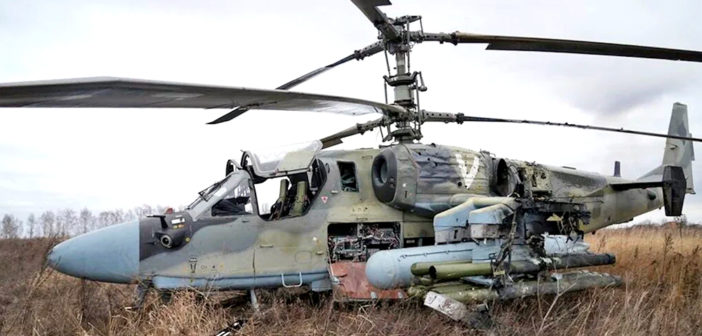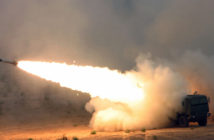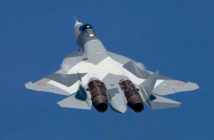According to Ukraine military intelligence investigators and their surprising inquest shared with selected NATO experts, when Ukrainian forces began to take apart several pieces of captured or partially destroyed Russian military equipment they found a strong reliance on foreign microchips — especially those made in the United States.
The chips in question were found inside a few first-hand recovered equipment, in mint condition or only slightly damaged, like : an abandoned Ka-52 « Alligator » twin-rotor attack helicopter, a Pantsir S air defense system, and a downed dud Kh-101 cruise missile among others. This as many other Russian equipment also revealed some interesting insides…
This revelation, published in the Ukrainian specialized press, offers some of the most detailed information to date about the extent of where the Russian military industry has been getting critical microchips from, like semiconductors and other components essential to improve existing models. The many items listed to date raise serious questions about Russia’s ability to produce in-house the technological components its war machine relies on and the ability of countries like the U.S. to keep those technologies secure and away from open competitors.
Ukrainian specialists found for instance U.S.-made chips — manufactured by AMD, Rochester Electronics, Texas Instruments, and Linear Technology — in the direction finder of a Pantsir (Russian: Панцирь, lit. ‘”Carapace”‘) missile air defense system. Moreover when they opened up the turreted electro-optical system of the Ka-52 Alligator, Ukraine specialists found no less than twenty-two U.S.-made chips and one Korean-made chip! The U.S. manufacturers included Texas Instruments, IDT, Altera USA (now part of Intel), Burr-Brown, Analog Device, Micron Technology, Linear Technology andd TE Connectivity!
Interestingly enough, while the U.S. and several other Western democratic nations instituted sanctions after Russia launched its full-on invasion of Ukraine on last February 24, that prevented selling Moscow a long list of equipment including microchips. Indeed there is no indication that any of the chips in these captured or destroyed Russian assets violated any of those provisions, a Washington ITAR expert said.
The origin of the microchips found in the listed Russian weapons is unclear. As these chips would not necessarily have to have been sourced directly from the U.S. manufacturers themselves. Also, there exists a massive and largely unregulated market for recycled chips, largely emanating from China, and many of them appear to be quite old. Ukraine intelligence officials who provided the component list to the U.S. also could not specify where all the chips originated from. NATO and U.S. military who reviewed the long list of components provided by Ukraine intelligence openly said they really raise a number of issues. It highlights a “total dependence on Western technology” in applications of integrated chips sets used in key sensitive working parts of current and new Russian weapon systems — may it be for targeting, navigation, communications and more.
At this stage, it also shows the “breakdown or non-existent U.S. controls » in ITAR (International Traffic in Arms Regulations), “both supporting investigations when found in foreign weapons.”
On May 11, the U.S. Commerce Secretary told a Senate hearing that sanctions against Russia were forcing it to seek alternate sources of key components : « We have reports from Ukrainians that when they find Russian military equipment on the ground, it’s filled with semiconductors that they took out of modern dishwashers and refrigerators. » While components found in commercial appliances, for instance, are harder to prevent falling into the wrong hands, U.S. officials do have the authority to prevent shipments of those dual-use chips if they consider the application to have critical military uses.
This highlights and offers the need for « a clear path to stopping Russian weapons success without being there, and a crash domestic program to stop the shipments of technology » from U.S. allies Australia, Canada, New Zealand and the United Kingdom, collectively known as the « Five Eyes ».
NATO experts have known for long that Russians have been using appliance parts in its tanks, that is not likely the case in the more sensitive systems laid out by Ukraine intelligence : « The optics in the Ka-52 armed helicopter targeting and the missile guidance systems are of the greatest concern ». As such, after the beginning of the war in Ukraine, the U.S. has stopped all direct and indirect shipments to Russia, Belarus and the respective Russian-backed regions in Ukraine, Luhan and Donetsk. This also includes technical support.
Intel, for instance, said while they can’t know where their chips wind up, they no longer do business with either Russia or Belarus. “While we do not always know nor can we control what products our customers create or the applications end-users may develop, Intel does not support or tolerate our products being used to violate human rights,” they said. « Where we become aware of a concern that Intel products are being used by a business partner in connection with abuses of human rights, we will restrict or cease business with the third party until and unless we have high confidence that Intel’s products are not being used to violate human rights. The U.S. company has suspended all shipments to customers in both Russia and Belarus. » Additionally, « Intel will continue to comply with all applicable export regulations and sanctions in the countries in which it operates; this includes compliance with the sanctions and export controls against Russia and Belarus issued by the US and allied nations. »
The issue of foreign components winding up in Russian military equipment despite sanctions has come up before, namely after Russia first invaded Ukraine in 2014 an annexed Crimea, it was hit with a previous round of sanctions. Those however apparently did not prove foolproof. It is unclear how concerned the U.S. Commerce Department might be over the microchips Ukraine intelligence said were found on the Russian air defense systems, helicopter, and cruise missiles.
According to the U.S. department, there is already a lot of evidence that existing sanctions are hurting Russia in this very field. Precisely as local military industry relies significantly on Western-produced items for their avionics, like the much retarded Sukhoi Su-75 Checkmate « Sixth generation » fighter has shown. And Ukraine claims that the older components Russia is using, particularly in the Kh-101, make them less effective. But given Russia’s reliance on the large numbers of microchips, semiconductors, and other components floating around — and its close relations with China, a top manufacturer and recycler of these parts — the long-term effects of sanctions, at least in regards to high-tech components like chips, remains to be seen. And much U.S. naive wishful thinking is there involved!
All was said by Lenin one century ago when the Communist institution started to spread worldwide : “The Capitalists will sell us the rope with which we will hang them”. <>




